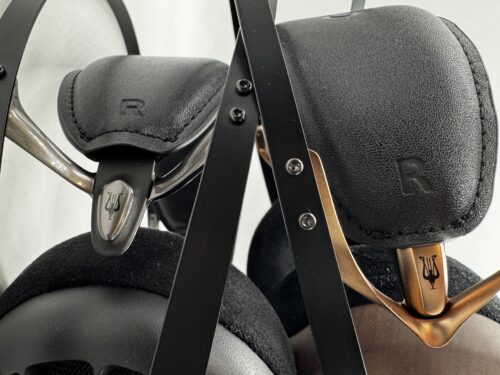Meze made waves when they introduced the Meze 109 Pro as it quickly became one of the best headphones under $1,000. Starting at $799, the 109 pro is a stellar value, giving you Meze design and sound at a fantastic price. But when the audio company announced the 105 AER at $399, people wondered if the new model would upstage its older sibling. Well today, we’re here to put each headphone through its paces and determine for whom each one might be for, and how they stack up in terms of their value. While they may not look the same, they do share a lot of similar DNA. So let’s get under the hood and compare these two headphones.
What’s in the Box:
| 105 AER | 109 Pro |
|
|
Build Quality: Meze 105 AER vs. 109 Pro:
When it comes to the overall shape of the headphones, the 105 AER looks quite a bit like the 109 Pro. But when you get a bit closer to the two headphones, there are some obvious, and some less obvious, differences in their builds. For starters, the 105 AER opts for a new grill design that looks almost more honeycomb-like than the 109 Pro, which uses a more straightforward approach that features simple lines.
In some places, materials remain the same between the two, while in others, the 105 AER simplifies materials used to reach a more affordable price. One place where things stay the same are in the suspension headband. Both headphones use a high quality and durable suspension headband system. On both headphones, it feels premium and getting the perfect fit is a breeze with the self-tensioning system in place.
That said, the ear cup materials are quite different. The 105 AER uses ABS-PC ear cups to get the job done while the 109 Pro goes for a more elegant black walnut wood. This isn’t to say the 105 AER feels flimsy or poorly constructed. But given the 99 Classics come with wood ear cups, it would have been nice to see the 105 AER continue the brand’s wood-loving aesthetic present somewhere in the design.
At each price range, and in terms of build, these are some of the best headphones for audiophiles. But when directly compared, the 109 Pro is a bit more elegant and sturdy.

Design and Technical Features of Meze 105 AER and 109 Pro:
Like with the build, there’s a lot in common between these two headphones. But upon closer inspection, things are actually quite different. Let’s start with the tech specs.
| 105 AER | 109 Pro | |
| Driver | 50mm dynamic | 50mm dynamic |
| Impedance | 42 ohms | 40 ohms |
| Sensitivity | 112 dB SPL | 112 dB SPL |
It’s in the deeper technical design that things get a bit more complicated. The 109 Pro’s diaphragm employs a dual-composite material featuring a Beryllium-coated polymer for the torus, a cellulose-carbon fiber composite for the dome, and a copper-zinc alloy stabilizer. These elements work together to enhance stiffness, reduce weight, and suppress unwanted resonances. This design is tailored for speed, accuracy, and a wide dynamic range.
While the 105 AER also uses a carbon fiber-reinforced cellulose composite dome for clarity and durability, it replaces the 109 PRO’s Beryllium-coated torus with PEEK (Polyether Ether Ketone). PEEK provides similar advantages, including enhanced stiffness, while its superior internal damping suppresses vibrations.
So again, it comes down to differences in materials that dictate the technical designs of these headphones. And while the 105 AER looks to offer comparable sound quality while using these more cost-effective materials, let’s jump into our sound impressions to get the real scoop.
Listening Impressions between the 105 AER and 109 Pro:
Low End:
Both headphones take a nuanced approach to the ways they handle bass. While neither headphone goes for a bombastic low end, they do each have a nice sense of finesse with how they handle low frequencies. Don’t get me wrong, there is a nice sense of dynamics on each set of headphones, but deciding which of the two is the best bass headphone is trickier than just how they match up in terms of sheer volume.
The 105 AER is a bit softer and smoother, with transients feeling a little less pronounced than the 109 Pro. The elder headphone simply has more attack and bite. The 105 AER, meanwhile, is a bit more laid back and out of the way. They have a similar character in being a bit more floaty and ethereal in the bass department, but the 109 Pro just has that extra bit of heft that makes for a more engaging and exciting bass response.
Mid Range:
The mids are quite similar between the 105 AER and 109 Pro. Both have a striking ability to be airy and present at the same time. Vocals are extremely well articulated on each, and I’m specifically impressed by the midrange dynamics of the 105 AER. Strums and strikes all sound vivid and clear. But where the 109 Pro offers an improvement is in its textural resolution. The 109 Pro simply feels more natural and clear than the 105 AER. That said, the 105 AER is still a great performer, and while it feels a tad more artificial when compared to the 109 Pro, it’s by such a smidgen that I think anyone could be happy with either of these headphones for mid range performance.
Top End:
Moving upwards towards the top end, things get even closer. I find the treble response to be the most impressive area for the 105 AER, and it’s the most similar element to the 109 Pro that the headphone offers. On both headphones, there’s a great sense of air and headroom, allowing instruments to feel more smooth and refined. The 105 AER doesn’t quite get to the heights of the 109 Pro, which is just slightly less fatiguing and overall a bit better at handling busy and complex passages.
Soundstage:
Given that one of the key design differences between these headphones is the ear cup material and grill layout, I was interested in seeing how the soundstages compared with each other. My findings are simple yet clear. While they both are capable of reaching similarly wide ranges of soundstage, the 105 AER images a bit more intimately than the 109 Pro. The 109 Pro feels more holographic and isn’t as strictly linear as the 105 AER.
Final Thoughts:
Meze’s 105 AER comes impressively close in performance to the 109 Pro, but in just about every category, the 109 Pro does seem worth the higher price. That said, I think each headphone is a great choice, depending on the person buying them. The 105 AER is an excellent choice for someone who wants to take a leap into the audiophile hobby. It’s relatively easy to drive and has a sophisticated but approachable sound signature.
The 109 Pro is the next step up, offering more refinement, a more luxurious build, and an improved soundstage. It’s the headphone for someone who wants to move into higher tier headphones, especially in the Meze ecosystem. The strongest factor in favor of the 109 Pro is that it still manages to bring impeccable value to the sub-1k range of headphones. With that in mind, both are really great values, it just depends what segment of headphone options you’re looking at.
The Meze 105 AER and 109 Pro are available at Audio46.
MAJORHIFI may receive commissions from retail offers.










